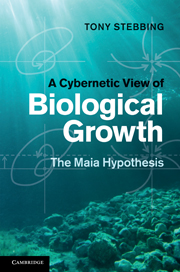Book contents
- Frontmatter
- Contents
- Foreword by Ernest Naylor
- Preface: ‘A fragment of a possible world’
- Acknowledgements
- 1 Introduction
- 2 Growth unlimited: blooms, swarms and plagues
- 3 Self-regulating systems: from machines to humans
- 4 The wealth of homeodynamic responses
- 5 A cybernetic approach to growth analysis
- 6 A control mechanism for Maia
- 7 The three levels of adaptation
- 8 Population growth and its control
- 9 Hierarchy: a controlled harmony
- 10 History of hormesis and links to homeopathy
- 11 Maian mechanisms for hormesis and catch-up growth
- 12 Cellular growth control and cancer
- 13 Human overpopulation
- 14 Our finite Earth
- 15 The Maia hypothesis and anagenesis
- Glossary
- Further reading
- References
- Index
Preface: ‘A fragment of a possible world’
Published online by Cambridge University Press: 10 January 2011
- Frontmatter
- Contents
- Foreword by Ernest Naylor
- Preface: ‘A fragment of a possible world’
- Acknowledgements
- 1 Introduction
- 2 Growth unlimited: blooms, swarms and plagues
- 3 Self-regulating systems: from machines to humans
- 4 The wealth of homeodynamic responses
- 5 A cybernetic approach to growth analysis
- 6 A control mechanism for Maia
- 7 The three levels of adaptation
- 8 Population growth and its control
- 9 Hierarchy: a controlled harmony
- 10 History of hormesis and links to homeopathy
- 11 Maian mechanisms for hormesis and catch-up growth
- 12 Cellular growth control and cancer
- 13 Human overpopulation
- 14 Our finite Earth
- 15 The Maia hypothesis and anagenesis
- Glossary
- Further reading
- References
- Index
Summary
Anyone who is practically acquainted with scientific work is aware that those who refuse to go beyond the facts, rarely get as far.
Thomas H. HuxleyTo give priority to invisible process, rather than tangible structure.
Douglas HofstadterThis book is the narrative of an idea about the control of biological growth that has developed over the course of my career. At an early stage it was given the name Maia, after the Roman goddess of spring, growth and fertility. The origin of the idea goes back to attempts to explain how it could be that toxic agents at low concentrations have the improbable consequence of stimulating growth. Later, perturbation experiments revealed the output of a control mechanism responsible for regulating growth. This breviary of the Maia hypothesis explains the central idea of the book. All that follows derives from the key finding of how to access the output of growth control mechanisms, as ultimately growth must be controlled and constrained. It is one of many homeodynamic processes, all controlled by cybernetic mechanisms. This account is pitched to make the biology accessible to cyberneticists, and the cybernetics accessible to biologists. These preliminary remarks therefore give the crux of the idea, summarising its development, in a few paragraphs, from growth experiments with simple organisms to the point where Maia bears on the two engines of growth on Earth.
During early sensitivity tests of a seawater bioassay with a clonal hydroid (see Frontispiece), it was discovered that low concentrations of toxic agents stimulate biological growth (‘hormesis’).
- Type
- Chapter
- Information
- A Cybernetic View of Biological GrowthThe Maia Hypothesis, pp. ix - xivPublisher: Cambridge University PressPrint publication year: 2010



